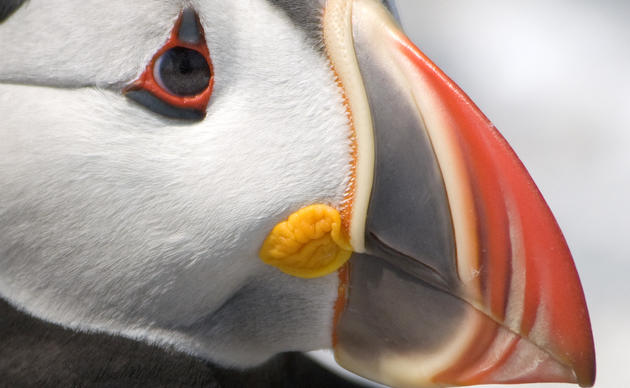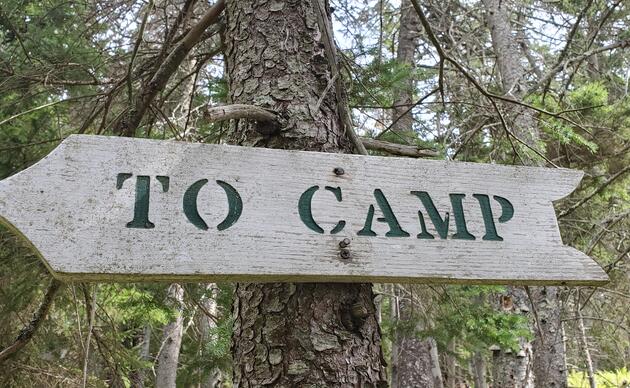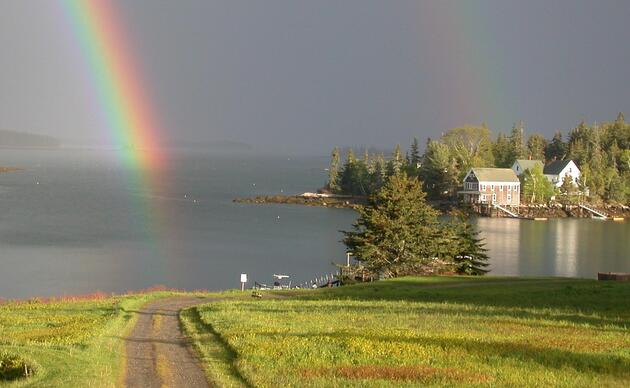Location and Description: Eastern Egg Rock (Knox, Co.) is a 7-acre island located in outer Muscongus Bay, 6 miles east of New Harbor. The treeless island is designated the Allan D. Cruickshank Wildlife Sanctuary in honor of this noted Maine ornithologist and photographer. The island is fringed by a berm of massive granite boulders that provide nesting habitat for puffins and guillemots. The interior habitat is home to nearly 4,000 pairs of nesting terns, laughing gulls and eiders. The rank vegetation, fertilized annually by the birds, is dominated by dense pasture grasses, raspberry, and elderberry. Eastern Egg Rock is owned by the Maine Dept. of Inland Fisheries and Wildlife and is managed by National Audubon Society through a cooperative agreement. The island is home to the Adopt-A-Puffins—some of which are more than 30 years old.
Seabird and Restoration History: The Island is home to the world’s first restored seabird colony. The methods initiated here in 1973 have been replicated dozens of times worldwideto help endangered and threatened seabirds. Like many Maine coast seabird colonies, nesting seabird populations were diminished and eventually extirpated by a combination of egging,hunting for meat and feathers, and displacement by expanding Herring and Great Black-backed Gull populations that have increased in response to fishing and municipalwaste. Prior to recolonization, puffins last nested in 1885 and terns last nested in 1936. Gull management, the translocation of nearly 1,000 young puffins from Newfoundland, and social attraction (decoys and mirror boxes) were the primary tools for restoring puffins. In response to the puffin restoration, five pairs of puffins began nesting in 1981; by 2008 101 pairs nested. Tern restoration relied on gull management and social attraction (decoys and sound), the first terns nested in 1980 and today the colony supports more than 1,350 pairs. Among these are about 150 pairs of endangered Roseate Terns, more than half of the Gulf of Maine population.
Access: The Island is closed to public visitation during the seabird breeding season (April 1st to August 31st). Organized tour boats visit the island daily during the breeding season for viewing the restored seabird colony. Staff transportation to the island is provided by the project boat or aboard one of two commercial tour boats. The Project's 23' Seaway (Lunda III) is moored near our summer office in Bremen, 8 miles north of Eastern Egg Rock. The trip to Eastern Egg Rock takes approximately 30 minutes. After mid-June, occasional staff transfers or supply drops may be done from puffin tour boats. All food, gear and personal equipment are rowed ashore in a small inflatable rowboat (stored on the island); the landing can be difficult due to surge and minimal protection– high tide is generally the preferred time to land. Island staff are oftenresponsible for securing supplies and groceries before heading to the island.
Island Living and Accommodations: During the field season, 4-5 people live and work on the island and with the exception of the supervisor; staff and volunteers remain on the island for an average of 2-3 weeks per stint. A 12'x12' cabin (affectionately dubbed the "Egg Rock Hilton") is the hub of the living quarters and serves as a kitchen, "dining room", office, equipment storage room, and research blind. The kitchen has a propane stove, and tiny refrigerator. There is an outdoor solar shower and composting toilet. Five tent platforms are provided for personal use and accommodate small tents with a footprint of 8'x8'. A solar system powers research needs.
Nesting and Migratory Birds: Breeding waterbirds include Arctic, Common and Roseate Terns, Laughing Gulls, Atlantic Puffins, Black Guillemots, Leach’s storm-petrels and Common Eiders. Razorbills and Manx Shearwater are often seen or heard at the island, suggesting these species may someday nest. Black Tern has nested once in 2008. Migrants are common at the beginning and end of the field season; 122 species (including breeding birds) have been recorded on the island since 2000, including several Maine notables; Bridled Tern, Sabine’s Gull, and Royal Tern.
Island Monitoring, Research and Management Projects: Atlantic Puffins, Common, Arctic, and Roseate Terns, Black Guillemots,The Eastern Egg Rock field season begins in mid May and continues through mid August. The island supervisor is responsible for coordinating the timing of specific projects and participation by staff and volunteers throughout the field season and for writing a final report. Work includes, but is not limited to the following projects; annual tern, eider, and laughing gull census, tern band resighting, tern chick provisioning, productivity and growth studies, puffin census, productivity, band resighting and provisioning studies, vegetation monitoring and management and daily weather and bird lists.
You will need Adobe Acrobat Reader to view pdf files. Adobe Acrobat Reader is a free plugin that works with your web browser. If you do not have it installed, you can download it by clicking the icon below:




